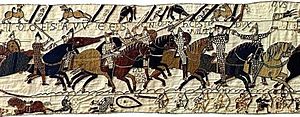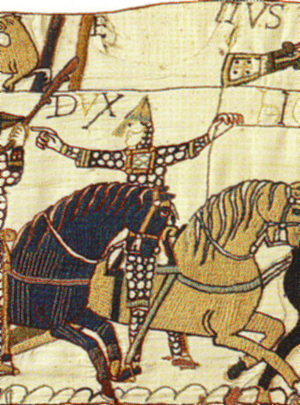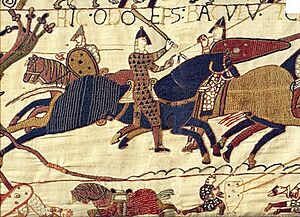Companions of William the Conqueror facts for kids

William the Conqueror led many different types of men at the Battle of Hastings in 1066. After this battle, he continued to conquer England over the next five years, including the difficult Harrying of the North.
The term "Companions of the Conqueror" usually means those who helped plan and fight with William, Duke of Normandy, during the Norman conquest of England (1066-1071). More specifically, it refers to the important nobles who actually fought alongside Duke William at the Battle of Hastings. This article focuses on these specific companions.
Contents
Who Really Fought at Hastings?
For centuries, many people in England have claimed their ancestors fought with William the Conqueror. While many Normans, Bretons, and Flemings did settle in England after 1066, we only have reliable proof for about 15 men who were with Duke William at the Battle of Hastings.
These 15 men are sometimes called the "proven companions." Many lists and "rolls" of other supposed companions have been made over time. But unless new evidence is found, these lists are just guesses and not historically accurate.
Our Clues: Old Books and a Tapestry
Only three main sources from that time are considered truly reliable for naming people who fought at the Battle of Hastings. These three sources together give us the names of only 15 companions.
- The Deeds of William II, Duke of the Normans: This book was written by William of Poitiers between 1071 and 1077. William of Poitiers was a chaplain to Duke William. His book describes the preparations for the Norman Conquest, the Battle of Hastings, and what happened afterward.
- The Ecclesiastical History: This large work was written by Orderic Vitalis, especially books 4 and 5. Orderic was born in England around 1075. He became a monk in Normandy and started writing his history around 1110.
- The Bayeux Tapestry: This is a long piece of embroidered cloth that tells the story of the Norman Conquest in pictures. It was likely made in Canterbury, England, soon after the battle in the 11th century. It shows many scenes and includes short descriptions.
These three sources are helpful, but they mostly tell the story from the Norman side. For example, William of Poitiers was not at the battle himself. Also, while both William of Poitiers and Orderic Vitalis say that Bretons were a big part of the army, they don't name any of them.
The Proven Companions
These are the 15 men whose presence at the Battle of Hastings is confirmed by the reliable sources:
- Robert de Beaumont: He was a young Norman noble fighting for the first time. He showed great bravery leading a group on the right side of the army. (Source: William of Poitiers)
- Eustace, Count of Boulogne: He tried to retreat during the battle but Duke William stopped him. Eustace was then badly wounded. (Source: William of Poitiers)
- William, Count of Évreux: (Source: William of Poitiers)
- Geoffrey, Count of Mortagne: (Source: William of Poitiers)
- William fitz Osbern: He later became the first Earl of Hereford. (Source: William of Poitiers)
- Aimeri, Viscount of Thouars: (Source: William of Poitiers)
- Walter Giffard: (Source: William of Poitiers)
- Hugh of Montfort-sur-Risle: (Source: William of Poitiers)
- Ralph de Tosny: (Source: William of Poitiers)
- Hugh de Grandmesnil: (Source: William of Poitiers)
- William de Warenne: He later became the first Earl of Surrey. (Source: William of Poitiers)
- William Malet: Duke William gave him the body of King Harold to bury after the battle. (Source: William of Poitiers)
- Odo, Bishop of Bayeux: He was William's half-brother. The Bayeux Tapestry shows him fighting with a club. (Source: Bayeux Tapestry)
- Turstin fitz Rolf: (Source: Orderic Vitalis)
- Engenulf de Laigle: (Source: Orderic Vitalis)
More Companions
Historians David C. Douglas and Geoffrey H. White agreed on five more names, bringing the total to 20:
- Geoffrey de Mowbray: He was the Bishop of Coutances. (Source: William of Poitiers)
- Robert, Count of Mortain: He was William's half-brother. (Source: The Bayeux Tapestry)
- Wadard: He is believed to have been a follower of the Bishop of Bayeux. (Source: The Bayeux Tapestry)
- Vital: He is also believed to have been a follower of the Bishop of Bayeux. (Source: The Bayeux Tapestry)
- Gilbert d’Auffay: (Source: Orderic Vitalis)
Later, J. F. A. Mason added one more name:
- Humphrey of Tilleul-en-Auge: (Source: Orderic Vitalis)
This brings the total number of generally accepted companions to 21.
Other Historical Lists
Over the years, many other lists of companions have been created. These include:
- The Song of the Battle of Hastings: A poem written shortly after 1066.
- The Romance of Rolf: Written by Wace around 1160-70, this list includes 116 names.
- The Battle Abbey Roll: Several versions of this list exist from the 16th century. The original was supposedly placed in Battle Abbey, built where King Harold died.
- Roll of Dives-sur-Mer: In 1862, 475 names were carved on a church wall in Normandy. These names are mostly from the Domesday Book, which lists Normans who owned land in England in 1086. Many of them might have fought at Hastings.
- Roll of Falaise: A bronze plaque put up in 1931 in the Château de Falaise lists 315 names.
These lists are interesting, but they are not as reliable as the three main sources from the time of the battle.



